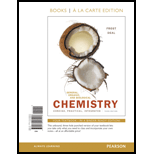
Concept explainers
a.
To classify:
The given alcoholic structure is primary, secondary or tertiary.
Introduction:
The numbers of alkyl groups attached to the carbon atom which are bonded to the hydroxyl group are classified as alcohols. The reactivity of alcohol is directly affected by the number of alkyl groups attached to the alcoholic carbon. The alcohols are of three types: primary alcohol, secondary alcohol and tertiary alcohol.
b.
To classify:
The given alcoholic structure is primary, secondary or tertiary.
Introduction:
The numbers of alkyl groups attached to the carbon atom which are bonded to the hydroxyl group are classified as alcohols. The reactivity of alcohol is directly affected by the number of alkyl groups attached to the alcoholic carbon. The alcohols are of three types: primary alcohol, secondary alcohol and tertiary alcohol.
c.
To determine:
The given alcoholic structure is primary, secondary or tertiary.
Introduction:
The numbers of alkyl groups attached to the carbon atom which are bonded to the hydroxyl group are classified as alcohols. The reactivity of alcohol is directly affected by the number of alkyl groups attached to the alcoholic carbon. The alcohols are of three types: primary alcohol, secondary alcohol and tertiary alcohol.
d.
To classify:
The given alcoholic structure is primary, secondary or tertiary
Introduction:
The numbers of alkyl groups attached to the carbon atom which are bonded to the hydroxyl group are classified as alcohols. The reactivity of alcohol is directly affected by the number of alkyl groups attached to the alcoholic carbon. The alcohols are of three types: primary alcohol, secondary alcohol and tertiary alcohol.
Want to see the full answer?
Check out a sample textbook solution
Chapter 6 Solutions
GENERAL ORGANIC+BIO...(LL)-W/MOD.ACCESS
- Calculate the pH and the pOH of each of the following solutions at 25 °C for which the substances ionize completely: (a) 0.000259 M HClO4arrow_forwardWhat is the pH of a 1.0 L buffer made with 0.300 mol of HF (Ka = 6.8 × 10⁻⁴) and 0.200 mol of NaF to which 0.160 mol of NaOH were added?arrow_forwardDetermine if the following salt is neutral, acidic or basic. If acidic or basic, write the appropriate equilibrium equation for the acid or base that exists when the salt is dissolved in aqueous solution. If neutral, simply write only NR. Be sure to include the proper phases for all species within the reaction. NaN₃arrow_forward
- A. Draw the structure of each of the following alcohols. Then draw and name the product you would expect to produce by the oxidation of each. a. 4-Methyl-2-heptanol b. 3,4-Dimethyl-1-pentanol c. 4-Ethyl-2-heptanol d. 5,7-Dichloro-3-heptanolarrow_forwardWhat is the pH of a 1.0 L buffer made with 0.300 mol of HF (Ka = 6.8 × 10⁻⁴) and 0.200 mol of NaF to which 0.160 mol of NaOH were added?arrow_forwardCan I please get help with this.arrow_forward
- Determine if the following salt is neutral, acidic or basic. If acidic or basic, write the appropriate equilibrium equation for the acid or base that exists when the salt is dissolved in aqueous solution. If neutral, simply write only NR. Be sure to include the proper phases for all species within the reaction. N₂H₅ClO₄arrow_forwardPlease help me with identifying these.arrow_forwardCan I please get help with this?arrow_forward
 Chemistry for Today: General, Organic, and Bioche...ChemistryISBN:9781305960060Author:Spencer L. Seager, Michael R. Slabaugh, Maren S. HansenPublisher:Cengage Learning
Chemistry for Today: General, Organic, and Bioche...ChemistryISBN:9781305960060Author:Spencer L. Seager, Michael R. Slabaugh, Maren S. HansenPublisher:Cengage Learning Organic And Biological ChemistryChemistryISBN:9781305081079Author:STOKER, H. Stephen (howard Stephen)Publisher:Cengage Learning,
Organic And Biological ChemistryChemistryISBN:9781305081079Author:STOKER, H. Stephen (howard Stephen)Publisher:Cengage Learning, General, Organic, and Biological ChemistryChemistryISBN:9781285853918Author:H. Stephen StokerPublisher:Cengage Learning
General, Organic, and Biological ChemistryChemistryISBN:9781285853918Author:H. Stephen StokerPublisher:Cengage Learning Introductory Chemistry: A FoundationChemistryISBN:9781337399425Author:Steven S. Zumdahl, Donald J. DeCostePublisher:Cengage Learning
Introductory Chemistry: A FoundationChemistryISBN:9781337399425Author:Steven S. Zumdahl, Donald J. DeCostePublisher:Cengage Learning World of Chemistry, 3rd editionChemistryISBN:9781133109655Author:Steven S. Zumdahl, Susan L. Zumdahl, Donald J. DeCostePublisher:Brooks / Cole / Cengage Learning
World of Chemistry, 3rd editionChemistryISBN:9781133109655Author:Steven S. Zumdahl, Susan L. Zumdahl, Donald J. DeCostePublisher:Brooks / Cole / Cengage Learning Organic ChemistryChemistryISBN:9781305580350Author:William H. Brown, Brent L. Iverson, Eric Anslyn, Christopher S. FootePublisher:Cengage Learning
Organic ChemistryChemistryISBN:9781305580350Author:William H. Brown, Brent L. Iverson, Eric Anslyn, Christopher S. FootePublisher:Cengage Learning





